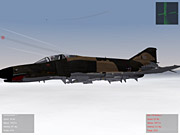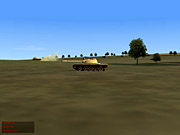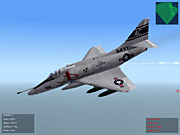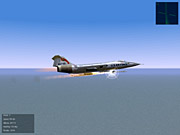Strike Fighters: Project 1 Updated Preview
We take another look at this flight sim from the developers of European Air War and Longbow II.
If you hadn't heard of Strike Fighters: Project 1 before, you probably did in conjunction with its disastrous premature release through Wal-Mart, where Strategy First shipped a press preview alpha version for retail and ended up with a bunch of recalled games when it became clear to buyers how far from completion the game really was. That leaves us in the odd position of previewing a game that some people may already have played and that even has had a "patch" applied. Nevertheless, the build we got was much more recent than the one released through Wal-Mart, and it looks like the game is actually shaping up to be a pretty good flight sim. This is hardly surprising, since the lead programmer and designer for the game, Tsuyoshi Kawahito (Third Wire founder), was also the lead designer on European Air War, which is still the standard for European theater WWII flight sims. For his own company's debut game, Kawahito chose the underappreciated 1960s as the setting, when jets were no longer new but air combat was still evolving very rapidly. You won't see a lot of radar-guided missile duels from beyond visual range, simply because the technology wasn't that advanced at that time. It's an interesting period in aviation history, and Third Wire has captured it well so far.

Strike Fighters: Project 1 is a classic "survey sim," with multiple flyable aircraft, and its emphasis is on providing a range of flying experiences rather than trying to model a single plane exhaustively. The game has four flyable aircraft types with several variants: the F-4 Phantom II (plus the B, C, D, and E models), the A-4 Skyhawk (plus the B, C, and E models), the F-104G Starfighter, and the F-100D Super Sabre. These were chosen for several reasons, including the fact that they were all US-built aircraft that were widely exported and thus make sense in the context of a fictional campaign where the opposing forces consist of Soviet-built weaponry. Third Wire also wanted to include multirole aircraft that would complement each other and allow for the illustration of advances in combat aircraft over the period of the 1960s. The various models of Phantom II, for example, do this quite nicely. On the opposing sided, you'll fly against the usual suspects from the Mikoyan-Gurevich design bureau, with the MiG-17, -19, and -21 all represented, along with the Su-7 Fitter and various larger aircraft. Friendly nonflyable aircraft include the B-57 Canberra, the C-130 Hercules, and the O-1 Bird Dog spotter plane.

The aircraft choices may disappoint those hoping for a straight-on Vietnam sim, but the game's planned expandability should allow both the company and modders to produce additional aircraft to flesh out the game universe. There is certainly no shortage of candidates for additional aircraft for modelers to choose from.
Considering the computing power available to today's flight sim enthusiasts, there really isn't any excuse not to have a good-looking sim, and Third Wire does a nice job with the graphics in several areas, most notably the aircraft models and skins, which are just beautiful. The terrain looks fine from up high, which is where you'll be seeing it from most of the time. Also outstanding are the 3D cockpits, with clear instrumentation and a very realistic look to them. The game ran fairly well on a low-end machine, albeit with medium graphics settings, while on our high-end Pentium 4 with all the settings maxed, it looked great and was extremely smooth.
Taking to the Skies
Strike Fighters: Project 1 is one of those games that will try to be all things to all people by appealing to both casual and hard-core simmers. The flight models, gunnery, and targeting options can all be individually tuned. At the easiest setting, it takes only a few hits to shoot down almost any aircraft. Targeting options can be set to always display enemy aircraft, including a handy pointer that indicates where they are if they are out of your current field of view. If you're not good at landings, they can be adjusted separately so that they're almost foolproof. By choosing the 1960s time period, Third Wire has neatly avoided having to model extensive avionics, which is the most complicated part of any hard-core study sim. (As a result, you can't fly the Phantom II in the backseat, which is just as well since with the simplified avionics there wouldn't be much to do.) With its simplified targeting options, you can play Strike Fighters as a lite sim and just cycle through your targets while keeping track of the enemy aircraft identified for you by the computer. It's a good way to get around the need to turn on invulnerability (as many casual players do) by making things easy while still providing the illusion of a challenge.

The challenge is no illusion on the more realistic settings. With all the options turned up to maximum realism, actually engaging enemy aircraft can be quite difficult, and if you're not careful you may end up splashing one (or more) of your wingmen. With the primitive radar sets of the time (if your aircraft is even lucky enough to have one), situational awareness becomes even more of an acquired skill. In this way, Strike Fighters feels a lot like MiG Alley, which was GameSpot's 1999 Sim of the Year. You won't find the flight models as challenging as in MiG Alley, which is how you would expect it to be, with an additional decade of jet development, but the need for close-quarters dogfighting skills and judicious use of unreliable missiles makes Strike Fighters a very challenging game if you decide to take it on without any training wheels.
With the realistic flight models turned on, the planes really showed off their capabilities, especially the Phantom flight model, which seemed to be the most complete. Its vertical performance highlighted its good thrust-to-weight ratio, and it had a poor turn radius and bled airspeed very fast in high-G turns. One thing we couldn't get planes to do easily was depart from controlled flight, even with the flight model on "hard."

The weapons of the time were far less accurate than they are today, and the need to maintain the proper aspect for heat-seeking missiles to lock on really emphasizes good flying skills over familiarity with a multifunction display. A lot of these planes carried limited ammo as well, and if you're playing with that option set to "realistic," you don't get many chances to pull the trigger. The planes definitely provide an interesting set of choices and challenges for the pilot, and learning the idiosyncrasies of each plane should give the sim a lot of longevity.
The Campaign
There was one flyable campaign in the version we played, titled Burning Sands, which was a fictional conflict set "somewhere in the Middle East" between two warring countries: the Kingdom of Dhimar and the Empire of Paran. Dhimar is outfitted with US-exported aircraft, which are the ones you fly, while Paran has the bad guys' toys. You start out flying an F-100D Super Sabre, and as time passes you get the opportunity to fly newer and better aircraft. In keeping with the game's customizability, you can set it so that you begin your missions in the air near your objective, and you can even jump from encounter to encounter, bypassing even the need to compress time between waypoints. Of course, you can also do everything the hard way. It's the ultimate jump-and-gun campaign without losing anything on the hard-core end.

The campaign is probably the least interesting thing about the game, and this has a lot to do with the generic nature of the missions and map, with enemy airbases designated P1 through P12. The missions are quite varied, from fighter sweeps and escort missions to suppressing enemy air defenses. Unfortunately, we had a hard time getting the enemy air defenses to actually engage us, so it was difficult to judge how well the surface elements interacted with the air game. At the higher difficulty settings, gunnery from enemy aircraft (especially tail gunners on bombers, like the Il-28 Beagle) became almost perfect, leading to these monstrosities being almost invulnerable from the rear. This gunnery problem isn't unique to Strike Fighters, though.
There are a lot of possibilities in the campaign in terms of how it progresses, because with a fictional setting you can throw in just about anything. The wide-open desert allows for plenty of ground-attack missions (especially with the A-4 Skyhawk available) and of course the usual "protect them, stop them, find them" assignments. Once again, the generic setting is a bit of a handicap when trying to create the kind of atmosphere that really draws you into a good flight simulation, but the variety of gameplay and interesting aircraft keep the game engaging. The game will offer both head-to-head and cooperative multiplayer play for single missions, although we were not able to test this aspect of the sim.

Our build had some issues, which is understandable given the fact that it was a beta build. Some lighting effects didn't seem to be finished, leading to some quirky display problems, and the sound effects also seemed incomplete. One thing that will need to be addressed is the slow default speed for both view panning and camera zoom. These can be edited in a configuration file, but for a simulation that takes such pains to make itself accessible to novices, having to find a line in a config file to make view panning tolerable is strange. Hopefully Third Wire will fix this. The controls themselves are completely user-configurable, so setting up your joystick and throttle is a breeze.
Despite its checkered history so far, Strike Fighters: Project 1 is clearly a well-designed game by a company that knows both what is important in a good simulation and what needs to be made adjustable in order to accommodate a wider audience. If the game has a problem-free release, and a mod community becomes established with proper support from Third Wire, simmers could be looking at a widely expandable game that will give them the chance to fly all sorts of interesting vintage jets in a realistic manner. It's something to look forward to, so here's hoping Third Wire can pull it off.
Got a news tip or want to contact us directly? Email news@gamespot.com
Join the conversation